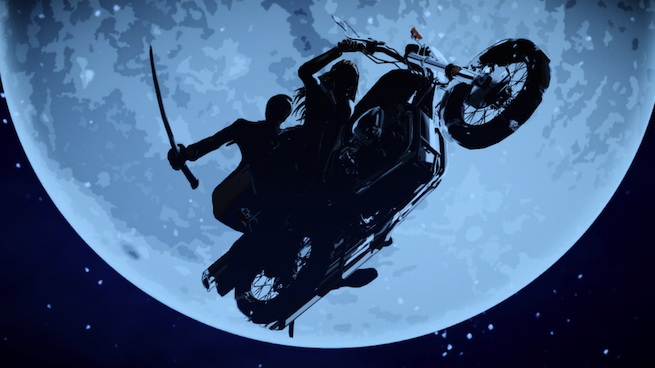For the uninitiated, the names Garcia Hotspur, Juliet Starling, and Travis Touchdown might sound like members of the latest pop group … or they might just be porn stars. Either way, they all have one person in common: Goichi Suda, a.k.a. “Suda 51.” The inventive game designer has a knack for coming up with great main characters, and Killer is Dead (out now for the Xbox 360 and PlayStation 3) is no exception.
Co-developed by Kadokawa Games and Suda’s Grasshopper Manufacture, Killer is Dead borrows almost everything that Suda 51 games are known for — slick presentation, bloody combat, bizarre humor — and packages it in a third-person action game that has you hacking and slashing your way to the moon and back. You play as Mondo Zappa, a suave hero who wears a skinny tie and fights with a katana and an arm that can transform into different guns.
Between Mondo, the Executioner Office he works for (think Ghostbusters meets The X-Files), and the targets they hunt down, Killer is Dead is weird, stylish, and, when the jokes work, funny. But it’s also inconsistent, confusing, and a little disturbing.
What you’ll like
The flow of combat
Mondo’s fighting skills are modest in comparison to other heroes like Dante (Devil May Cry) or Kratos (God of War), but what he lacks in quantity he more than makes up for in quality. It all starts with his sword, which feels satisfying from the moment he swings the blade to the moment it slices through his enemies. In reality, you’re just mashing one button while dodging or blocking incoming attacks with another — a simple setup — but the immediacy and impact of the blade (along with its fantastic sound effects) never gets old.
A lot of Mondo’s moves (like dashing or side-stepping) focus on controlling the distance between him and his foes, so each battle is a cerebral dance of giving and taking: Lose too much ground, and you’re out of range, but close-in too tight and the enemies will box you in. Killer is Dead experiments with this idea of spacing when it comes to level design as well. Large, rectangular arenas provide plenty of square feet to move around while smaller areas, like narrow hallways, force you to consolidate and be economic with your attacks.
Moves like Guard Burst and Adrenaline Burst, which makes you quickly hone in on one specific enemy and deliver deadly strikes, adds another layer of complexity. After I finished Killer is Dead, all I wanted to do was to keep fighting. Since that wasn’t possible outside of restarting story missions, I resorted to playing a bunch of its challenge modes — which I rarely touch in action games — to scratch that itch.
Its monster-of-the-week vibe
The ultimate goal in Killer is Dead is to eliminate your assigned targets, encounters which usually take the form of a traditional boss fight. The twist is that these guys and gals all have some sort of supernatural power (like transforming into giant spiders or demonic musicians), so each battle plays out in a slightly different way. The bosses and the stories behind them were my favorite parts of each chapter because each successive creature was either bigger or meaner than the last.

















